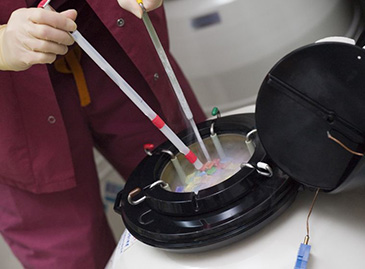
Ovarian Cysts and Surgery: Types, Risks, and Recovery
Ovarian cysts, though a typical appearance among ovary owners, might be suspicious and lead to ovarian cancer. Thus, they require removal through surgery.
What are the ovaries?
Your ovaries are small organs located deep within your pelvis. Eggs grow inside them, within a sac or follicle. During ovulation, the ovaries release an egg in its sac into one of your fallopian tubes. After that, the sac typically dissolves, but sometimes, the sac can remain and fill with air or fluid to develop into a cyst. Cysts that form in or around your ovaries often go unnoticed. They may cause only mild symptoms or no noticeable symptoms at all.
What are ovarian cysts?
Cysts are fluid-filled sacs that can grow undetected on the ovaries. Many women have cysts on their ovaries that they cannot feel, which come and go with their menstrual cycle. Usually, you can't handle a cyst unless the ovary twists or the cyst ruptures or grows big enough to feel it.
Ovarian cysts occur commonly in women of all ages. Some women with ovarian cysts have pain or pelvic pressure, while others have no symptoms. Irregular menstrual periods are not usually related to an ovarian cyst.
Fortunately, most ovarian cysts do not require surgical removal. They are not caused by cancer. Cysts can vary from less than one centimetre (one-half inch) to greater than 10 centimetres (4 inches).
Ovarian cysts and cancer
It's relatively rare, but some ovarian cysts are malignant or cancerous. Fortunately, most are benign or not cancerous. Your doctor's recommended treatment plan will depend on the type of ovarian cyst or tumour that you have, as well as your symptoms. Often, they won't require any treatment.
Symptoms of ovarian cysts
Ovarian cysts may be either symptomatic or asymptomatic. Women with symptoms from ovarian cysts typically experience pain or pressure in the lower abdomen on the side of the cyst. This pain may be dull or sharp, constant or come and go. Crampy lower abdominal pain is not usually related to ovarian cysts. If an ovarian cyst ruptures, a woman may experience a sudden sharp pain, which may be severe. Women with torsion (twisting) of an ovary may feel pain along with nausea and vomiting. Abnormal periods or vaginal bleeding are not usually related to ovarian cysts.
Benign or malignant ovarian cysts
Your doctor will examine the ultrasound to look for clues if the cyst is likely benign – non-cancerous – or if it has characteristics suspicious for cancer. Clues that tell if it is a benign cyst are:
- It is simple-looking and fluid-filled
- No solid growths
- It has no extra blood flow to it
Clues that make the doctor more suspicious of this mass would be that it appears more complex in the ultrasound image, some areas have a solid appearance, and an increased blood supply flows to it.
If the cyst looks benign, the doctor may advise you to watch your cyst through a series of ultrasound tests over a few months. Or, they may suggest the cyst be removed in surgery. A general gynaecologist can remove a cyst. If there are clues that this mass could be cancer, you will be referred to a cancer surgeon (a gynecologic oncologist) for further examination and consultation. The cancer surgeon can remove the mass. If it is determined to be cancer, they can also remove lymph nodes. This is to see if the cancer has spread. If there is cancer in other areas that are found during surgery, it will be removed.
Getting referred to a gynecologic oncologist doesn't mean you have ovarian cancer. It means your doctor saw something suspicious and wants to provide you with the best care and an opinion from someone who can suggest the best action plan. If it is determined that the cyst is likely benign, it may be recommended that you return to your general gynaecologist for observation or removal.
Surgery for Suspicious Ovarian Cysts
In most cases, ovarian cysts disappear in a few months without the need for treatment.
The requirement of treatment depends on:
- Its size and appearance
- Whether you have any symptoms
- Whether you've had menopause – if you are postmenopausal, there is a slightly higher risk of ovarian cancer.
Watchful waiting
In most cases, doctors recommend a policy of "watchful waiting".
This means you will not receive immediate treatment, but you may have an ultrasound scan a few weeks or months later to check if the cyst has gone.
For instance, if you have been through menopause, you may be advised to have ultrasound scans and blood tests every four months for a year. This is because you have a slightly higher risk of ovarian cancer.
If the scans show that the cyst has disappeared, further tests and treatment are not usually necessary. Surgery for suspicious ovarian cysts may be recommended if the cyst is still there.
Surgery
Significant or persistent ovarian cysts, or cysts that are causing symptoms, usually need to be surgically removed.
Surgery is also generally recommended if there are concerns that the cyst could be cancerous or could become cancerous.
There are two types of surgery for suspicious ovarian cysts:
- laparoscopy
- laparotomy
- These are usually carried out under general anaesthetic.
Laparoscopy surgery for suspicious ovarian cysts
- This is a type of keyhole surgery. Minor cuts are made in your tummy, and gas is blown into the pelvis to allow the surgeon to access your ovaries.
- A laparoscope (a small, tube-shaped microscope with a light on the end) is passed into your abdomen so the surgeon can see your internal organs. The surgeon then removes the cyst through the minor cuts in your skin.
- After removing the cyst, the surgeon closes the cuts using dissolvable stitches.
- Most people can go home on the same day or the following day.
Laparotomy surgery for suspicious ovarian cysts
- During a laparotomy, a single, more significant cut is made in your tummy to give the surgeon better access to the cyst.
- The whole cyst and ovary may be removed and sent to a laboratory to check whether it's cancerous. Stitches or staples will be used to close the incision.
- You may need to stay in the hospital for a few days after the procedure.
What happens after the surgery?
The time it takes to recover from surgery is different for everyone. After a laparoscopy or a laparotomy, it may take as long as 12 weeks before you can resume normal activities.
If the cyst is sent off for testing, the results should return in a few weeks, and your consultant will discuss whether you need further treatment.
If your test results show that your cyst is cancerous, both of your ovaries, your womb (uterus) and some of the surrounding tissue may need to be removed.
This would trigger early menopause and mean that you're no longer able to get pregnant.
What are some complications that may arise after surgery for suspicious ovarian cysts?
Contact your doctor if you notice the following symptoms during your recovery:
- Heavy bleeding
- Severe pain or swelling in your abdomen
- High temperature (fever)
- Dark or smelly vaginal discharge
- These symptoms may indicate an infection
Can ovarian cysts recur after surgery?
Some types of ovarian cysts are more likely to recur than others. This includes endometriomas and functional ovarian cysts. If you are premenopausal and are concerned about recurrent cysts, taking a birth control pill or other hormonal forms of birth control may help to prevent ovarian cysts from developing.
How will the doctor know from my ovarian cyst that it is cancerous?
To confirm or rule out ovarian cancer, your doctor may perform a biopsy. They will collect a sample of the cyst or tumor for analysis under a microscope. This will help them determine if it’s cancerous.
Gynecologic Oncology Price Turkey



